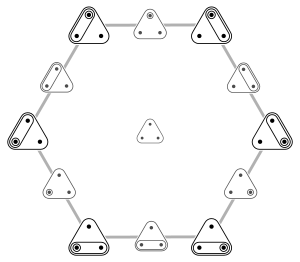
In geometry, the cyclohedron is a d-dimensional polytope where d can be any non-negative integer. It was first introduced as a combinatorial object by Raoul Bott and Clifford Taubes and, for this reason, it is also sometimes called the Bott–Taubes polytope. It was later constructed as a polytope by Martin Markl and by Rodica Simion. Rodica Simion describes this polytope as an associahedron of type B.
The cyclohedron appears in the study of knot invariants.
Construction
Cyclohedra belong to several larger families of polytopes, each providing a general construction. For instance, the cyclohedron belongs to the generalized associahedra that arise from cluster algebra, and to the graph-associahedra, a family of polytopes each corresponding to a graph. In the latter family, the graph corresponding to the -dimensional cyclohedron is a cycle on vertices.
In topological terms, the configuration space of distinct points on the circle is a -dimensional manifold, which can be compactified into a manifold with corners by allowing the points to approach each other. This compactification can be factored as , where is the -dimensional cyclohedron.
Just as the associahedron, the cyclohedron can be recovered by removing some of the facets of the permutohedron.
Properties
The graph made up of the vertices and edges of the -dimensional cyclohedron is the flip graph of the centrally symmetric triangulations of a convex polygon with vertices. When goes to infinity, the asymptotic behavior of the diameter of that graph is given by
- .
See also
References
- Bott, Raoul; Taubes, Clifford (1994). "On the self‐linking of knots". Journal of Mathematical Physics. 35 (10): 5247–5287. doi:10.1063/1.530750. MR 1295465.
- Markl, Martin (1999). "Simplex, associahedron, and cyclohedron". Contemporary Mathematics. 227: 235–265. doi:10.1090/conm/227. ISBN 9780821809136. MR 1665469.
- ^ Simion, Rodica (2003). "A type-B associahedron". Advances in Applied Mathematics. 30 (1–2): 2–25. doi:10.1016/S0196-8858(02)00522-5.
- Stasheff, Jim (1997), "From operads to 'physically' inspired theories", in Loday, Jean-Louis; Stasheff, James D.; Voronov, Alexander A. (eds.), Operads: Proceedings of Renaissance Conferences, Contemporary Mathematics, vol. 202, AMS Bookstore, pp. 53–82, ISBN 978-0-8218-0513-8, archived from the original on 23 May 1997, retrieved 1 May 2011
- Chapoton, Frédéric; Sergey, Fomin; Zelevinsky, Andrei (2002). "Polytopal realizations of generalized associahedra". Canadian Mathematical Bulletin. 45 (4): 537–566. arXiv:math/0202004. doi:10.4153/CMB-2002-054-1.
- Carr, Michael; Devadoss, Satyan (2006). "Coxeter complexes and graph-associahedra". Topology and Its Applications. 153 (12): 2155–2168. arXiv:math/0407229. doi:10.1016/j.topol.2005.08.010.
- Postnikov, Alexander (2009). "Permutohedra, Associahedra, and Beyond". International Mathematics Research Notices. 2009 (6): 1026–1106. arXiv:math/0507163. doi:10.1093/imrn/rnn153.
- Pournin, Lionel (2017). "The asymptotic diameter of cyclohedra". Israel Journal of Mathematics. 219: 609–635. arXiv:1410.5259. doi:10.1007/s11856-017-1492-0.
Further reading
- Forcey, Stefan; Springfield, Derriell (December 2010), "Geometric combinatorial algebras: cyclohedron and simplex", Journal of Algebraic Combinatorics, 32 (4): 597–627, arXiv:0908.3111, doi:10.1007/s10801-010-0229-5
- Morton, James; Pachter, Lior; Shiu, Anne; Sturmfels, Bernd (January 2007), "The Cyclohedron Test for Finding Periodic Genes in Time Course Expression Studies", Statistical Applications in Genetics and Molecular Biology, 6 (1): Article 21, arXiv:q-bio/0702049, doi:10.2202/1544-6115.1286, PMID 17764440
External links
- Bryan Jacobs. "Cyclohedron". MathWorld.
 -dimensional cyclohedron is a cycle on
-dimensional cyclohedron is a cycle on  vertices.
vertices.
 is a
is a  -dimensional
-dimensional  , where
, where  is the
is the  vertices. When
vertices. When  of that graph is given by
of that graph is given by
 .
.